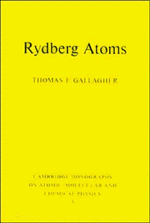Book contents
- Frontmatter
- Contents
- Preface
- 1 Introduction
- 2 Rydberg atom wavefunctions
- 3 Production of Rydberg atoms
- 4 Oscillator strengths and lifetimes
- 5 Black body radiation
- 6 Electric fields
- 7 Pulsed field ionization
- 8 Photoexcitation in electric fields
- 9 Magnetic fields
- 10 Microwave excitation and ionization
- 11 Collisions with neutral atoms and molecules
- 12 Spectral line shifts and broadenings
- 13 Charged particle collisions
- 14 Resonant Rydberg–Rydberg collisions
- 15 Radiative collisions
- 16 Spectroscopy of alkali Rydberg states
- 17 Rf spectroscopy of alkaline earth atoms
- 18 Bound He Rydberg states
- 19 Autoionizing Rydberg states
- 20 Quantum defect theory
- 21 Optical spectra of autoionizing Rydberg states
- 22 Interseries interaction in bound states
- 23 Double Rydberg states
- Index
14 - Resonant Rydberg–Rydberg collisions
Published online by Cambridge University Press: 29 September 2009
- Frontmatter
- Contents
- Preface
- 1 Introduction
- 2 Rydberg atom wavefunctions
- 3 Production of Rydberg atoms
- 4 Oscillator strengths and lifetimes
- 5 Black body radiation
- 6 Electric fields
- 7 Pulsed field ionization
- 8 Photoexcitation in electric fields
- 9 Magnetic fields
- 10 Microwave excitation and ionization
- 11 Collisions with neutral atoms and molecules
- 12 Spectral line shifts and broadenings
- 13 Charged particle collisions
- 14 Resonant Rydberg–Rydberg collisions
- 15 Radiative collisions
- 16 Spectroscopy of alkali Rydberg states
- 17 Rf spectroscopy of alkaline earth atoms
- 18 Bound He Rydberg states
- 19 Autoionizing Rydberg states
- 20 Quantum defect theory
- 21 Optical spectra of autoionizing Rydberg states
- 22 Interseries interaction in bound states
- 23 Double Rydberg states
- Index
Summary
Resonant energy transfer collisions, those in which one atom or molecule transfers only internal energy, as oppposed to translational energy, to its collision partner require a precise match of the energy intervals in the two collision partners. Because of this energy specificity, resonant collisional energy transfer plays an important role in many laser applications, the He–Ne and CO2 lasers being perhaps the best known examples. It is interesting to imagine an experiment in which we can tune the energy of the excited state of atom B through the energy of the excited state of atom A, as shown in Fig. 14.1. At resonance we would expect the cross section for collisionally transferring the energy from an excited A atom to a ground state B atom to increase sharply as shown in Fig. 14.1. In general, atomic and molecular energy levels are fixed, and the situation of Fig. 14.1 is impossible to realize. Nonetheless systematic studies of resonant energy transfer have been carried out by altering the collision partner, showing the importance of resonance in collisional energy transfer.
The use of atomic Rydberg states, which have series of closely spaced levels, presents a natural opportunity for the study of resonant collisional energy transfer. One of the earliest experiments was the observation of resonant rotational to electronic energy transfer from NH3 to Xe Rydberg atoms by Smith et al.
- Type
- Chapter
- Information
- Rydberg Atoms , pp. 290 - 313Publisher: Cambridge University PressPrint publication year: 1994



